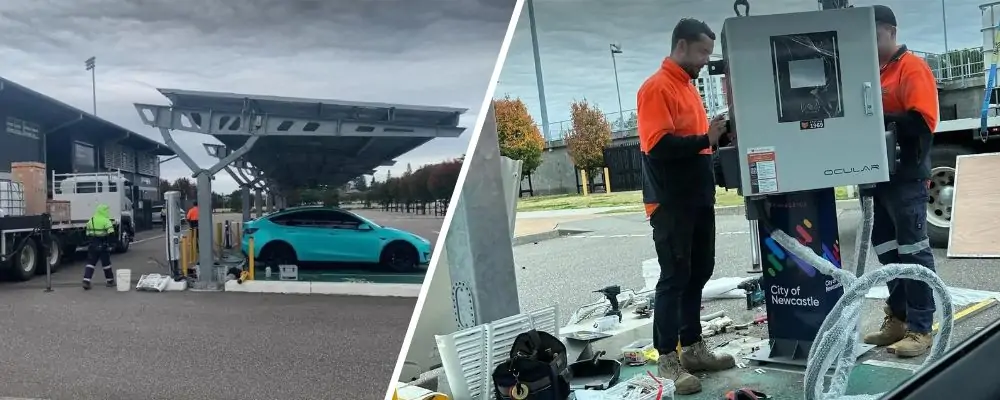How to replace a broken DC Charger

EVSE specialises in keeping EV charging infrastructure working long term. However, as the industry evolves, many people may find themselves needing to upgrade or replace their existing infrastructure. This could be due to product failure, outdated plugs or vandalism.
See Example of Tritium RT unit in “Newcastle, NSW, Australia” replaced by Ocular Titan DC charger above
Reliability in charging infrastructure is critical to staying ahead of the electric vehicle (EV) curve, particularly in business settings. As EV adoption rises and technology develops, it becomes not only necessary to replace outdated DC chargers but also a chance to improve efficiency and meet growing demand.
It’s important to evaluate your current charging infrastructure and future needs before upgrading outdated DC chargers. Take into account elements like:
- Locations and layouts of the current chargers
- Electrical infrastructure and power capacity
- Demand for charging and usage trends
- Compatibility with current and present EV models
- Standards set by the industry and regulations
Having a clear understanding of these factors will help you choose the best replacement DC charger choices for your commercial environment.
Choose the right replacement chargers
It is essential to choose the appropriate replacement DC chargers to guarantee long-term dependability, efficiency, and compatibility. Important things to think about are:
- Charging standards: Depending on the EV models being used, select chargers that support frequently used standards like CHAdeMO, CCS (Combined Charging System), or Tesla Supercharger.
- Power output: Take into account the chargers’ power output to effectively satisfy the various EVs’ charging requirements.
- Scalability: Choose charging options that are adaptable to future expansion and rising demand.
- Features: For best performance and economy, look for features like smart charging capacity, remote monitoring, and energy management system compatibility.
Schedule for Integration and Installation
It takes meticulous preparation and cooperation to replace outdated DC chargers to minimise downtime and guarantee a smooth transition. Important actions consist of:
- Site setup: Assess current infrastructure, including connectivity and electrical capacity, and make any required improvements or changes.
- Charger placement: Based on user convenience, parking arrangement, and accessibility, decide where the new chargers will be most useful.
- Installation: To ensure a safe and effective installation, work with certified electricians or contractors that have installed EV charging stations before.
- Integration: For a smooth user experience and operation, integrate the new chargers with the current software platforms, payment systems, and infrastructure.
Test and Commission the New Chargers:
To ensure functionality and performance, comprehensive testing and commissioning are necessary when the new DC chargers are installed. This comprises:
- Functional testing: Verify that every charger functions properly and provides compatible EVs with the anticipated power output.
- Testing for compatibility: Make sure the chargers are compatible and interoperable with a range of EV models.
- Safety testing: To avoid electrical dangers, confirm that all safety systems, such as insulation monitoring and overcurrent protection, are operating as intended.
- Testing for user acceptance: Ask EV users to test the new chargers and report back on their general satisfaction, dependability, and usability.
Provide training and support:
Provide instruction and assistance to those involved in running and maintaining the charging infrastructure as part of the switch to the new DC chargers. This comprises:
- Instruction on the safe and efficient use of the new chargers for EV owners, maintenance personnel, and facility managers.
- Continuous technical assistance and resources for troubleshooting to handle any problems or queries that might come up.
- Plans for routine upkeep and servicing to guarantee the charging equipment’s lifetime and optimum performance.
Please see a quick summary of the steps required.
- Identify the Type and Model of the DC Charger: Determine the type and model of the DC charger you need to replace. Often you can try to find a second-generation unit or look for an equivalent
- Purchase a Replacement Charger: Once you’ve identified the type and model, purchase a suitable replacement charger. Ensure that the replacement charger matches the specifications of the original one in terms of voltage, current, and connector type. It’s essential to get the right charger to avoid needing to upgrade or change the electrical infrastructure on the site
- Power Off and Disconnect the Device: Before replacing the charger, make sure to power off the device and disconnect it from any power source to avoid any electrical hazards.
- Remove the Old Charger & Dispose Properly: If the old charger is no longer functional, consider disposing of it properly. Many electronic stores and recycling centres accept old chargers for recycling to prevent environmental pollution.
- Connect the New Charger: Use a specialist contractor to connect the new charger to the device and the power outlet. Ensure that the connections are secure.
- Power On and Test: Once the new charger is connected, power on the device and test if it’s charging properly. Check for any signs of malfunction or commissioning required.
- Read the User Manual : If you’re unsure about any specific instructions for your device, refer to the user manual for guidance on replacing the charger.
Remember to always use chargers that are compatible with your EV to avoid damage or safety hazards. If you’re unsure about any step or if the replacement process seems complicated, it’s advisable to seek assistance from a professional such as EVSE.
In a commercial context, swapping out outdated DC chargers for electric vehicle (EV) chargers is a calculated investment that will improve charging infrastructure, meet increasing demand, and prepare your company for the coming electric mobility revolution. You can guarantee a seamless and effective shift to a more dependable, efficient system by adhering to these guidelines and best practices.
Please see Example in “Newcastle, NSW, Australia” of older DC Charger replaced with the Ocular DC Charger


Have any questions? Contact us:
Phone: 0800 990 032
Email: sales@evse.nz


